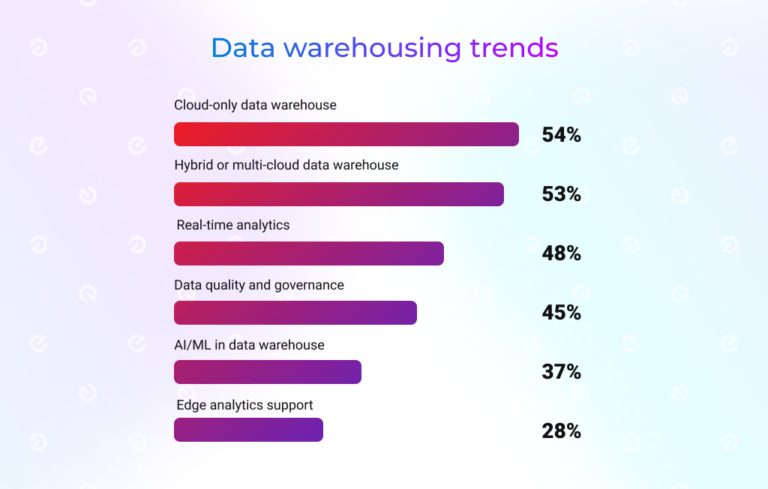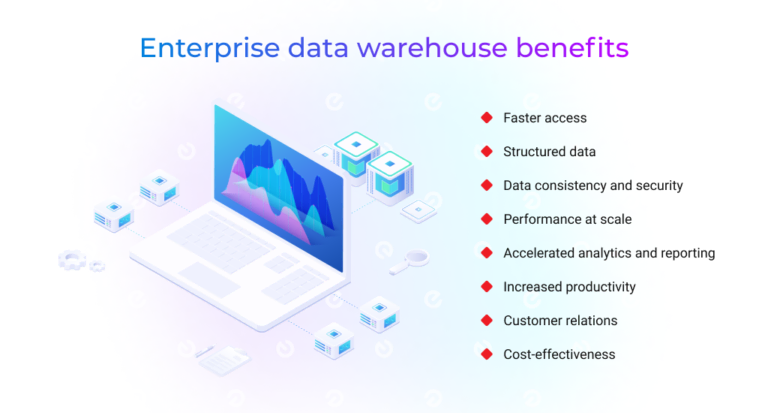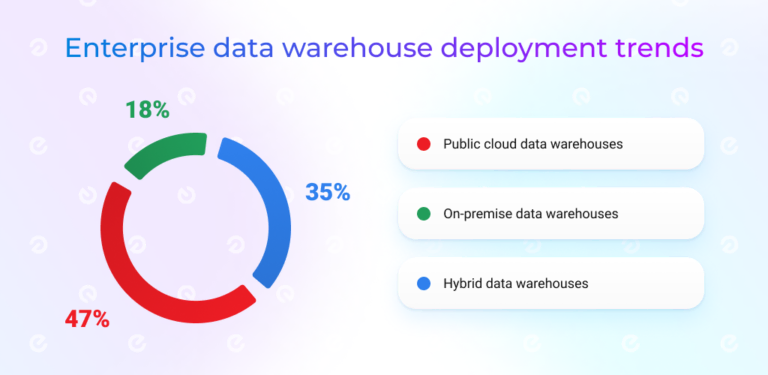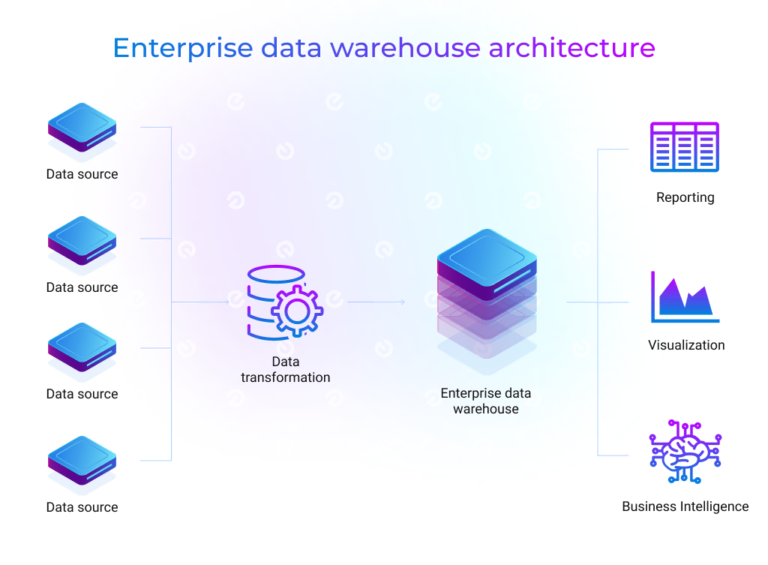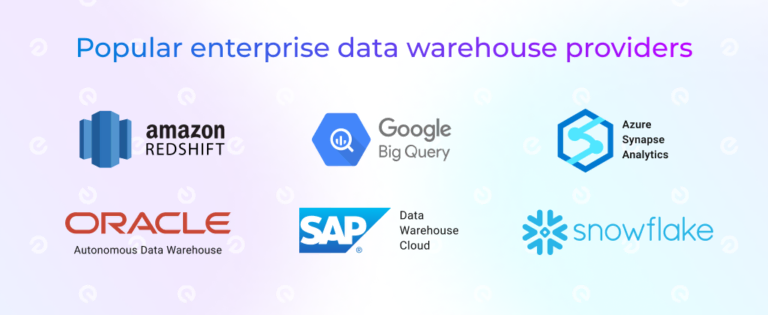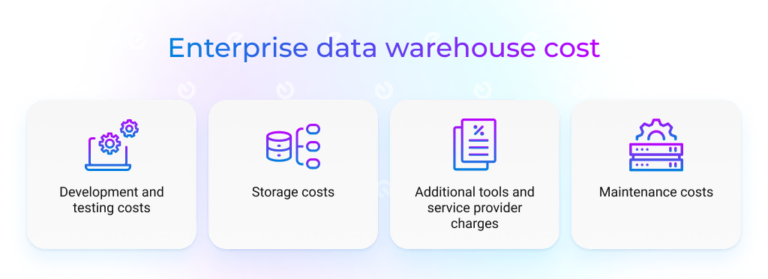
Updated: July 3, 2025
Published: February 15, 2022
Why are data-driven decisions so valuable? How do businesses improve through the use of data? The higher value the enterprise puts on data, the more intelligent decisions it can make. However, it isn’t that easy to analyze and manage all the collected data. Teams realize the necessity of new and innovative solutions for data proficiency, community, and analytics agility. That is where the enterprise data warehouse (EDW) is introduced. So, let’s check on what is an enterprise data warehouse, its types, architecture, benefits, and some useful tips on choosing the right solution for your enterprise.
List of the Content
- What is an enterprise data warehouse?
- Enterprise data warehouse benefits
- Types of enterprise data warehouses
- EDW architecture sample
- Enterprise data warehouse vendors
- Enterprise data warehouse cost
- How to look for good enterprise data warehouse solutions?
- In conclusion
WHAT IS AN ENTERPRISE DATA WAREHOUSE
The importance of data has never been so enormous as it’s at present. Enterprises are in need of effective ways to collect, manage and analyze data. One of the main challenges is that data is usually housed in different sources, and its amount is constantly increasing. But is it possible to organize all the data even after transformations and changes enterprises go through regularly?
The great news is that the answer is yes. Today’s businesses have a unique chance to attain a single data source. Of course, it’s a complex solution that requires some effort, whereas its benefits remain substantial.
This solution is known as an enterprise data warehouse. It’s a centralized data repository that structures and stores all the historical data of an enterprise. Also, it prepares business data for efficient analytical and reporting purposes. The enterprise data warehouse definition can be explained as a single database of all sources from different business areas.
Enterprise data warehouse solutions collect data from various sources, including on-premise and cloud ones. The data will come from production apps, physical records, ERP, CRM, and other software. The primary purpose of enterprise data warehousing is to capture data through the entire organization.
What is an enterprise data warehouse?
It’s a unified repository that stores, structures, processes, and analyzes data for better decision-making within the entire enterprise.
It helps to transform the way of incorporating data-driven and analytical approaches into the overall business operations. The collected data will be leveraged through efficient integration of multiple sources, centralized analysis, and high business intelligence. It’s become a future-proof approach to managing huge data sets and presented the opportunity to transform raw data into valuable insights.
The emerging trends of data warehousing significantly contribute to the global market growth. According to the statistics, it is estimated to reach more than $30 billion by 2025.
Regardless of the industry specification, enterprises understand the importance of structured and analyzed data. Most enterprises have already started investments in data warehousing and real-time analytics that support future growth and profitability. Due to its increasing amount, large enterprises were among the early adopters of such solutions.
The enterprise data warehouse isn’t only the storage solution, but it provides access to valuable data across different departments. That helps give a better vision of daily operations handled within the organization. For example, marketing and sales departments can share details on the customers’ path, thus improving the user experience from discovery to purchase. It brings more context and shows valuable insights for improving marketing strategy and increasing sales.
Enterprise data warehousing helps to consolidate and standardize data regardless of its source. At the same time, effective data transformation provides valuable insights leveraging both historical and current data. Therefore, enterprises have the unique ability to integrate data from numerous sources for centralized analysis and business intelligence.
ENTERPRISE DATA WAREHOUSE BENEFITS
It’s worth noting that most enterprises share common concerns for data accuracy, security, and consistency. Therefore, the EDW can become a workable solution to handle these challenges.
The rising popularity of the enterprise data warehouse is easily explained with the benefits and solutions it can offer. Besides, data warehousing is steadily increasing in value and adopts new approaches for better efficiency. So, what enterprise data warehouse benefits do businesses get?
Faster access
The first advantage to mention is fast access to data. Since the business obtains the unified repository, it gets immediate access to ever occurring data in the organization. It manages the entire data flow, whether it is generated internally or externally.
Structured data
That is something that differentiates data warehousing from data lakes that collect unstructured data. The enterprise data warehouse is used to standardize and structure various data types and prepare them for accurate reporting and analytical analysis.
Data consistency and security
Enterprise data warehousing is a highly-secure and compliant solution. It enables data consistency across all the organization’s levels, whereas it supports access control with user authentication. Besides, it follows different compliance regulations like HIPPA, GDPR, etc.
Performance at scale
The great advantage is that the enterprise data warehouse provides scalability and speed. It allows teams to upscale or downscale without influencing the solution performance. The enterprises leverage flexible approaches to manage increasing amounts of data and optimize the performance to meet rising needs.
Accelerated analytics and reporting
Actionable insights are highly valued in the market. It’s hard to imagine some enterprises that don’t rely on it. Real-time analytics and accurate reporting are among the top business requirements today. It helps achieve unified analytical and reporting capabilities while adopting transparent and flexible approaches.
Increased productivity
Smooth data integration and efficient management always result in better productivity throughout the entire enterprise. It leads to increased staff performance, better communication between departments, and understanding of rising business needs.
Customer relations
We shouldn’t forget the fact that the EDW solution also provides a better vision of user needs. Predictive analytics become pretty helpful in building use scenarios, improving business decisions, and retaining your customers.
Cost-effectiveness
The performance and productivity improvements often lead to the profitability increase. As the enterprise data warehouse provides efficient tools for managing and scaling data, it considerably reduces the operational costs and decreases the ROIs.
Stability
Enterprise data warehousing stores and consolidates data for every business area. The organization has no difficulties handling data regardless of periods or parameters. Provided that the data is placed in the warehouse, it quickly becomes available for modifying and updating accordingly to rising needs.
The possibility to accelerate productivity and performance within the enterprise is a real value. The efficient usage of data and analytics enable the organization to deliver insights and define the best strategy directions.
TYPES OF ENTERPRISE DATA WAREHOUSES
Before the enterprise proceeds with data warehouse implementation, they need to choose the deployment model. That’s a quite decisive aspect as it impacts the way to implement the EDW and its maintenance aspects.
Due to the deployment approaches, enterprise data warehouse solutions are divided into three types: on-premise, cloud, and hybrid. Let’s consider every option and find major differences between them. The main thing to remember is that it’s related to where and how data will be stored and processed.
The on-premise enterprise data warehouse is delivered by means of hardware and software purchased by the enterprise itself. They are fully responsible for building, deploying, and further maintenance.
The cloud-based enterprise data warehouse is deployed in the cloud. Thus the enterprise doesn’t need to obtain or maintain required software and hardware. They choose to partner with enterprise data warehouse vendors that take most responsibilities.
The hybrid enterprise data warehouse combines both on-premise and cloud solutions. The team can mitigate operations and tasks by mixing the public cloud and on-premise resources.
Making a choice could be easier when the team is aware of the pros and cons of data warehousing types. Also, it’s a good idea to learn market tendencies and check the best market practices.
On-premise EDW
Pros:
- The in-house team gets full control over the solution.
- The rigid data access policies enforce data security compliance.
Cons:
- Expensive hardware and software to deliver the required infrastructure.
- The in-house team takes full responsibility for implementation and maintenance.
- Regular storage expending to gain scalability.
Use case: It can be used by businesses that apply standardized approaches without complex analytics or considerable advancements.
Cloud EDW
Pros:
- Highly flexible solutions with both upscaling and downscaling opportunities.
- Cloud-based services improve speed across the entire enterprise.
- In-build security features in compliance with the latest standards and regulations.
- Reduced cost due to the expense elimination on hardware and maintenance.
Cons:
- It’s required to enforce strict cost protocols to achieve gains in cost management.
- Limitations on data residency could not be suitable for some enterprises.
- Vendor lock-in unless it’s properly planned.
Use cases: Since everything is set up by enterprise data warehouse vendors, cloud solutions suits enterprises with different needs and specifications.
Why is cloud migration so popular among enterprises?
Check the article about the cloud migration process, applied strategies, and benefits to get.
Hybrid EDW
Pros:
- The hybrid solutions bring advantages of both on-premises and the cloud; thus, it’s good for workload and change management, scalability, data security, etc.
Cons:
- Increased expenses as the teams still maintain the on-premise infrastructure and purchase subscriptions from enterprise data warehouse vendors.
Use cases: It’s adopted by enterprises that want to retain control with certain data that can’t be moved to the cloud. Also, this approach is used as the halfway stage before the complete migration to the cloud.
Depending on the enterprise requirements, teams need to find a suitable model to get more advantages. As for the market share, we can observe the rising popularity of the cloud-based enterprise data warehouse. According to the statistics, they make almost half of the deployed solutions in the market.
ENTERPRISE DATA WAREHOUSE ARCHITECTURE SAMPLE
In order to gain a better understanding of what is an enterprise data warehouse, it’s important to discover more details on the solution architecture. That’s exactly what helps to support the data flow and meet the user expectations.
The first thing to mention is that it always depends on the project requirements what type of architecture to implement. Besides standard approaches, teams have the possibility to customize the delivery process.
However, there is something that is valid for all enterprise data warehouse solutions. The enterprise data warehouse design has to bring all the data together and perform well at any scale.
The typical EDW covers the following layers regardless of the architecture design.
Data layer – That area focuses on combining any data type ( unstructured, structured, or semi-structured) from all the included data sources.
Enterprise data warehouse – Before the data is placed in the warehouse, it goes through certain manipulations. That can be handled utilizing data integration and ETL (Extraction, Transformation, and Loading) tools. They basically bring into operation a data layer so it can be loaded in the enterprise data warehouse. The warehouse has to contain all the necessary functionality to clean, standardize and dimensionalize the collected data. Depending on the warehouse complexity, it requires a different architecture design:
- One-tier architecture
- Two-tier architecture including a data mart level
- Three-tier architecture including a data mart level and an online analytical processing (OLAP) layer
Depending on the needs and requirements, teams have all the necessary tools to extend functionality for better performance. The key objective will remain the same as they all focus on creating one hub for all the data. They just vary components to deliver solutions with confidence.
Reporting layer – Highly structured data provides enterprises with detailed reporting and analytical capabilities. EDW reporting allows teams to access required data quickly and easily. Moreover, it supports better connections between all the enterprise departments. This layer carries out essential tasks like forming reports, visualizing data, and analyzing business information. Moreover, it can be greatly advanced when introducing AI and ML in the data warehouse. The core task is to present collected and transformed data to the end-users visually.
The EDW architecture selection is an essential step for its successful implementation. It helps outline the required set of components and tools to deliver the chosen solution. Besides, that supports product integration into the existing data environment and defines the enterprise data warehouse strategy.
ENTERPRISE DATA WAREHOUSE VENDORS
The cloud-based and hybrid solutions are adopted through a partnership with enterprise data warehouse vendors. These third-party providers offer a wide range of services related to data warehousing. They help design the proper enterprise data warehouse architecture to maintain the historical data and gain valuable analytical insights for your organization.
Cloud data warehouses have quickly gained popularity; thus, it’s important to address more details on available providers. Learning about the top market providers, it’s worth saying that some of them belong to the cloud market aggregators like AWS, Azure, or Google Cloud. Due to the wide variety of services, they have the necessary tools to provide organizations with the required enterprise data warehouse services.
 Amazon Redshift
Amazon Redshift
It presents a great solution for analyzing semi-structured and structured data using SQL. Amazon Redshift supports the opportunity to collect data from operational databases, data lakes, and data warehouses. Besides, it enables native integrations with the AWS ecosystem as well as other third-party tools. Amazon Redshift is among the top market choices due to its greatest performance at any scale. They offer the following features:
- AQUA (Advanced Query Accelerator)
- Concurrency Scaling
- Data Sharing
- AWS Data Exchange
- Amazon Redshift Serverless (preview)
- Query Editor v2.0
- Amazon Redshift RA3 instances
- Amazon Redshift ML
Google BigQuery
That is an excellent option to adopt the multi-cloud data warehouse. BigQuery offers a secure and scalable platform to deal with a large volume of data. Analytical queries, real-time access, intelligence tools allow enterprises to improve operational and business processes. Also, BigQuery can be used for migration from data warehouses of other providers. Its main features include:
- BigQuery Omni
- BigQuery materialized views
- BigQuery GIS
- BigQuery Serverless
- BI Engine
- BigQuery ML
- BigQuery Data Transfer Service
Azure Synapse Analytics
Microsoft presents its enterprise data warehouse services via Azure Synapse Analytics. It is known for fast deployment, SQL queries, excellent scalability, native integrations with Azure ML and Power BI. They also offer Azure Synapse Pathway, the special solution for accelerating data warehouse migration. Here are some of the other popular features offered by this provider:
- Synapse SQL
- Synapse Studio
- Apache Spark for Azure Synapse
- Azure Machine Learning
- Azure Cognitive Services
- Power BI
- Azure Synapse Pathway
Interested in more details about other cloud services?
We recommend checking our latest article with the detailed comparison of Azure vs AWS services.
Oracle Autonomous Data Warehouse
That is another option to receive the self-driving solution in cloud data warehousing. It is easy to use and efficient to operate, secure and advance all the necessary processes. Built-in data tools focus on reducing the analytical workloads and receiving valuable insights. Commonly, it becomes the choice for enterprises that want to query data in Oracle Cloud Infrastructure. Check the following functionality list:
- Oracle Data Pump
- Oracle SQL Loader
- Query External Data
- Graph Studio
- Oracle Application Express
- Oracle REST Data Services (ORDS)
- Oracle Machine Learning Notebooks
SAP Data Warehouse Cloud
SAP has built an advanced business technology platform to address different tech and business needs. As for EDW solutions, they offer SAP Data Warehouse Cloud. It lays the solid foundation to embed end-to-end data management and improve decision-making. SAP Data Warehouse Cloud can be a good choice for hybrid approaches in order to extend the existing on-premise deployments. Among the known functionality, you can find:
- SAP BW bridge
- SAP Data Intelligence Cloud
- SAP Analytics Cloud
- SAP Crystal solutions
- SAP HANA
- SAP BW/4HANA
Snowflake
Snowflake delivers cloud-agnostic data warehouse services based on the SaaS model. The advantage of this solution relies on the ability to implement the multi-cluster shared architecture. It allows enterprises to allocate resources from several cloud providers like Azure, AWS, and GCP while remaining the same user experience. Multiple service connections and automated maintenance functionality help reach great performance and relevance to business processes. This provider presents the following solution:
- Snowflake for Analytics
- Snowflake for Data Lakes
- Data Engineering
- Snowflake for AI
- Snowflake for Data Sharing
- Snowflake Quickstart Service
WHAT FORMS AN ENTERPRISE DATA WAREHOUSE COST?
Choosing enterprise data warehousing also involves addressing an important question of implementation and maintenance costs. It isn’t surprising that cost-effectiveness is among the top business priorities. Every enterprise is looking for a return on made investments. Besides saved costs, it covers benefits that accelerate the growth and drive new business opportunities.
As for the cost estimation in enterprise data warehousing, teams have to consider numerous aspects. There isn’t one correct answer to define the required budget. The implemented solutions vary in complexity, deployment types, a number of data sources, enterprise data warehouse architecture, etc. Besides, they differ due to applied strategies and chosen vendors.
To better understand this question, it’s recommended to estimate expenses by needs teams face. Enterprise data warehouse cost estimation can start with defining the following details:
Storage costs
Storage expenses make a considerable part of the required budget. Enterprise data warehousing is all about handling large amounts of data that obviously remain subject to storage. And based on whether the enterprise selects cloud or on-premise storage, the price becomes significantly different. With on-premise storage, the teams invest upfront to purchase hardware and develop the infrastructure. It is always a significant investment with further expenses on its maintenance. Other enterprises choose to partner with public service providers like Google Cloud Storage, Amazon S3, or Microsoft Azure. The average cost of public cloud storage could start from $18 per TB/month.
Development and testing expenses
In order to implement the enterprise data warehouse, the team has to undergo a comprehensive process. It involves architecture design, data transformation, query optimization, ETL/ELT setup, custom app development, testing, team training, etc. The enterprise needs to form a professional team to deliver the functional solution. Here you can check the average salary rates of specialists commonly involved in the process.
- Information system manager – $151,150
- Data analyst – $93,730
- Information security analyst – $103,590
- Data architect – $98,860
- Software developers – $110,140
How to set up your professional team?
Contact EXISTEK to find more details on how to hire a dedicated development team according to your needs.
Additional tools and service provider charges
Estimating these details is important right at the beginning of EDW implementation. Careful requirement analysis could define the need to obtain additional tools like BI and analytical ones. And often they will be offered at extra costs. Therefore, the team with well-outlined needs knows how to balance the budget and look for alternatives when required. The other thing to know is how enterprise data warehouse vendors introduce the pricing structures. Here are some of the important aspects that influence the final price:
- Amazon Redshift – number and price of nodes, storage volume
- Google BigQuery – ETL tools, complexity and number of user queries, streaming insert quantity, storage volume
- Azure Synapse Analytics – ETL tools, warehouse units, storage volume
Maintenance costs
Like with any other project, the enterprise data warehouse delivery is only halfway. After successful implementation, it’s essential to educate staff across all departments to be aware of new processes and tools. It could require additional resources, but it streamlines capabilities and improves productivity. As for the further maintenance cost, enterprises with on-premise solutions incur every operating expense. At the same time, the EDW service providers take this responsibility with already covered pricing rates.
As a result, we can say that costs vary from project to project but can definitely optimize while carefully planned.
HOW TO LOOK FOR GOOD ENTERPRISE DATA WAREHOUSE SOLUTIONS
Numerous advancements prove the wide adoption of tech solutions within enterprises. Regardless of specification, they pursue the same goal to gain positive improvements across different business areas. But it is hard to reach that without efficient data processing, analytics, and reporting. That has turned into powerful tools to make the right decisions and make great progress.
With the proper usage of data, companies can get real value. The decision to introduce the enterprise data warehouse covers such essential needs as:
- Data storage
- Data integration
- Automated data management
- Data accessibility
- Data security and compliance
- Advanced analytics
- Company-wide reporting
- Improved performance
- Strategic decision-making
The process of introducing the EDW is quite complex and lengthy if not properly addressed. Careful planning and comprehensive analysis of business needs always have to be considered. As a result, the company can make important decisions faster and easier and streamline the overall process.
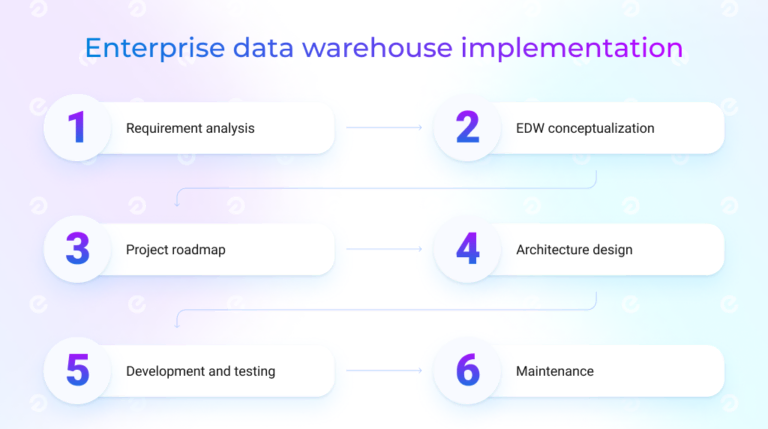
- Identify the enterprise objectives along with user expectations
- Impose the special requirements – it’s necessary to be aware of all the possible needs, including current and future ones
- Outline the data volume and the number of required sources
- Determine the requirements to ensure security and compliance
- Define main components for enterprise data warehousing
- Design the enterprise data warehouse architecture
- Choose the appropriate deployment model – according to the latest tendencies, the cloud solution is the most popular and advantageous in the market
- Define the scope of the project, including timelines and budget
- Carry out the risk assessment
- Partner with professional enterprise data warehouse vendors with first-hand experience
- Build the EDW and continue with constant improvements
These are the common steps in finding an efficient solution for your business. Of course, the DWH projects vary in complexity and applied approaches. Moreover, enterprise data warehousing can differ over the primary needs. Besides developing the enterprise data warehouse from scratch, some teams can look for the solution to redevelop, migrate or optimize the existing data warehouse.
The technology variety allows them to go with more advanced solutions. There are many cases when enterprises decide to transfer data to a new warehouse, change the provider or redevelop a solution on a new platform.
The main thing to remember is that there isn’t one right choice for all enterprises. On the contrary, everything relies upon deliberate decisions and your business-specific requirements. The advancement of the data warehousing market provides all the necessary functionality and tools to implement your reasonable solution.
IN CONCLUSION
The enterprise data warehouse solutions are advanced tools to improve efficiency across the entire business. That’s an all-in-one solution of storing, transforming, processing, and utilizing data to streamline the decision-making process. It isn’t surprising that data-driven approaches allow the market to reach record levels. Enterprise data warehousing is the right decision to meet needs within every industry and offer workable solutions for different business cases.
Have you considered enterprise data warehouse services?
Feel free to contact EXISTEK. We are a professional software development company with a decade-long experience to offer assistance and answer your additional questions.
Frequently asked questions
What is an enterprise data warehouse?
The EDW solutions deliver the centralized repository for efficient decision-making by storing, structuring, processing, and analyzing historical and current data.
What are the popular enterprise data warehouse providers?
The following providers take the top market positions:
Amazon Redshift
Google BigQuery
Azure Synapse Analytics
Oracle Autonomous Data Warehouse
SAP Data Warehouse Cloud
Snowflake
On-premise EDW vs cloud EDW: which is better?
Cloud solutions have become the obvious winner due to such advantages as high scalability, good performance, reduced costs, in-built security, easier maintenance, and great support from the service providers.
How to estimate the enterprise data warehouse cost?
To make an accurate estimate, the company needs to calculate expenses on:
Storage costs
Enterprise data warehouse development and testing costs
Additional tools and service provider chargers
Further maintenance costs

